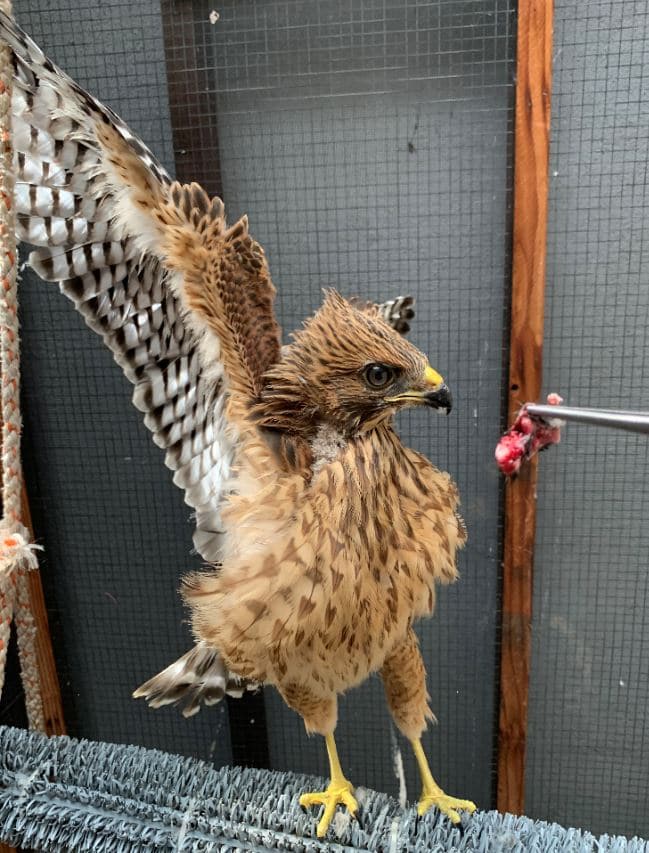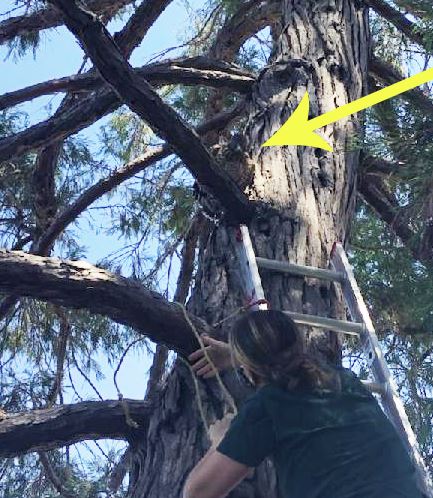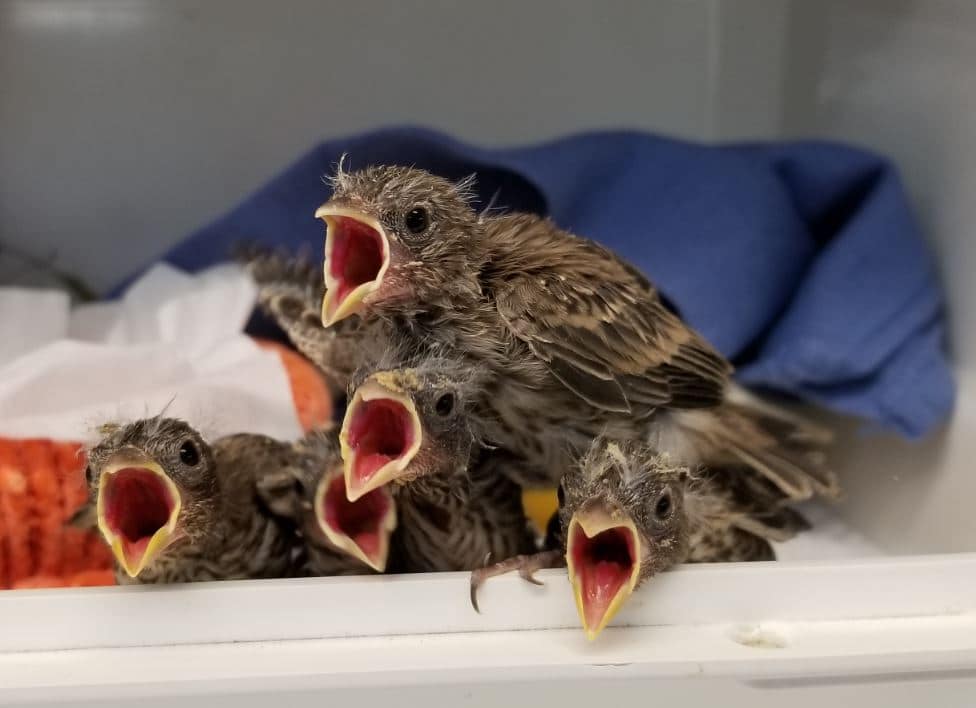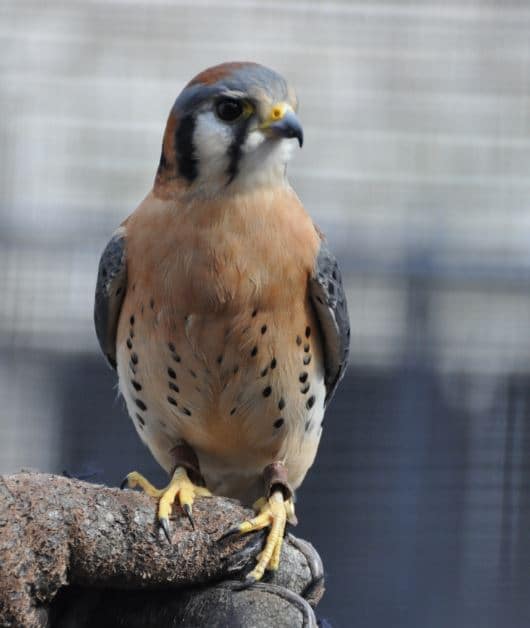Click here to sponsor a group of baby animals in WildCare’s Wildlife Hospital in honor of Dad.
Then send him an eCard to let him know you’ve made a gift to help baby wildlife in his name!

This young Red-shouldered Hawk toppled from his nest high in a eucalyptus tree during the high winds that hit our region last week.
At this age he should be practicing flapping and building his flight strength while still in the care of his parents.
He can’t yet fly, and he wouldn’t be able to survive on his own on the ground. Fortunately his rescuer found him and brought him to WildCare.
These hawks won’t feed their young on the ground, so this young bird was thin and dehydrated on intake. A full exam in the Wildlife Hospital determined that he had probably been on the ground for a couple of days, although fortunately he hadn’t injured himself in his fall.
This is frequently the case… young birds are very light, and they are able to use their wings to sort of float to the ground. We frequently find them uninjured and eligible to be reunited with their parents.
We kept this hawk in care while our Raptor Reunite Team went into action to find the nest and determine if the parent birds were still feeding a sibling there.
At this age, this bird’s parents would be bringing him whole food, but also still tearing some of it up for him, as he is in the process of learning to do that on his own. Because he was not used to our hospital set-up he was not self-feeding in care, so we supplemented with tweezer feeds to teach him that this was his food source and to help him build up his weight.
In the video below you can see that he is very defensive and doesn’t want anything to do with humans, even ones who offer him food! We knew this bird’s best chance was to get him back to his mom and dad. The crows you hear in the background are wildlife patients in the next aviary over.
 Our reunite team successfully found the nest, and observed that the parent birds were actively caring for the sibling still in the nest.
Our reunite team successfully found the nest, and observed that the parent birds were actively caring for the sibling still in the nest.
Last Sunday they climbed a ladder and placed this fledgling onto a branch in a tree nearby to allow him to make his way back up to the nest.
With a younger bird, having a volunteer arborist climb the tree and physically place the baby bird into the nest is usually the best choice, but with a bird this age, allowing him to hop-fly back up is the best method to reunite the family.
It worked! The video below shows him making his way back up to the nest. He successfully transitioned from the tree we placed him in over to the nest tree, and at last check, both fledglings were in the nest, receiving care from their mom and dad.
Who’s the Best Dad?
All the wonderful human dads in our lives may be surprised to hear that they have some competition for the title “Best Dad” among our wild neighbors.
The male Red-shouldered Hawk is responsible for providing food for his mate as she incubates their eggs and broods their nestlings. The male hawk will bring food to a spot near the nest and then call loudly for the female. She will accept the prey he has caught and deliver it to the young hawks. What a good Dad!
While they are nestlings, the mother hawk stays nearby, but by the time the young have reached the age of our young patient, both the male and the female hawks must hunt for food to keep their chicks’ bellies full. The young fledge when they are between 35 and 45 days old. At about seven weeks of age, they start capturing their own prey.
Hunting is hard, so at first they catch primarily insects, but after several weeks they start to catch rodents as well.
Bird Dads
The young of precocial species of birds, like turkeys, ducks and chickens, whose youngsters are able to walk and eat solid foods soon after hatching are comparatively easy to raise. The little ones only need to watch Mom and start pecking or dabbling, so only Mom is responsible for their care.
But for the altricial species of birds — songbirds, raptors and others, raising baby birds is so labor-intensive that both parents have to work. Baby birds need to be fed nearly continuously from dawn to dark (or from dusk to dawn for nocturnal birds), and different species use different tactics.
Some bird parents share just about all their duties evenly. Others share some chores, and divide up the others. According to some researchers, orphaned male songbirds may be at a disadvantage in the mating game if Dad isn’t around to teach them their love songs.
Like our Red-shouldered Hawk family, most other raptor parents divvy up the responsibilities of raising their young, with the female doing most of the incubating and the male doing most of the hunting. These amazing wild Dads really deserve kudos for successfully raising their demanding chicks!
Salute to Foster, Adoptive, and Step Dads
You certainly don’t have to be the biological father of a baby to be a wonderful dad! WildCare’s Wildlife Ambassador American Kestrel Kele is a testament to that.
 If he had been a wild kestrel, Kele would have done the majority of hunting to feed his mate and their chicks. Kestrel dads work hard!
If he had been a wild kestrel, Kele would have done the majority of hunting to feed his mate and their chicks. Kestrel dads work hard!
But Kele seems to have been raised as a pet– he came to WildCare after landing at a family’s picnic and attempting to steal food from their hands. Based on his behavior, we suspect he was taken from the wild as a baby and reared by humans who then released him, assuming he would know how to hunt on his own. He apparently wasn’t able to successfully hunt, and he was emaciated and dehydrated upon intake to WildCare. Kele now lives in our Courtyard as one of our educational animals.
When we admitted a baby kestrel to the Wildlife Hospital, our first thought was to get the baby a foster parent. Kestrels are high stress patients, and difficult to raise. We didn’t know if Kele would have the instincts of a wild father kestrel to care for a chick, but we thought we’d give him the chance. After an introductory period, we placed the chick and a camera into a carrier and gave Kele plenty of food to potentially bring to the baby.
We were incredibly gratified to see that Kele is a WONDERFUL dad! Watch him gently care for the chick in the video below, and appreciate how much this funny wobbly baby benefited from Kele’s care! Kele has helped successfully rear three kestrel chicks, demonstrating what an excellent dad he is to chicks of all ages.
WildCare wishes dads of ALL types and all species a very happy Father’s Day!
Watch Kele the American Kestrel show off his parenting skills with a foster chick in the Wildlife Hospital.
Sponsor Baby Animals in Dad’s Name!
 How your sponsorship helps WildCare’s babies:
How your sponsorship helps WildCare’s babies:
$25 could purchase a heating pad (to substitute for a mother’s warmth) that will see several groups of orphaned wild babies through their first months of care.
$50 could provide nearly a week’s worth of fruits and vegetables full of necessary nutrients to help your babies grow up strong and healthy.
$100 could buy a good gram scale that will help our babies’ foster care providers quickly determine if a problem is developing.
$250 could help purchase a brooder box or an incubator to keep babies warm and safe when they are at their smallest.
$500 could pay for enclosures, fencing or caging to give babies the space they need to learn survival skills and build strength for release.
WildCare supporter Eileen sent this wonderful video of coyote pups playing on her back deck. Mom, dad and the
entire extended coyote family work hard to raise healthy pups like these!
Mammal Dads
Since mammal mothers have mammary glands that provide nourishment for the young, mammal fathers aren’t as necessary as food providers. But there are exceptions.
Aside from some primate fathers (like ours) and those of a few other species, the canines win paws-down. Fox, coyote and wolf fathers all play a major role in canine family life.
Coyotes and wolves live in extended family packs, and the whole family helps feed, protect and babysit the new pups. The WildCare supporter Eileen who filmed the coyote pups on her back deck (above) says she’s seen the parent coyotes sunning themselves down the garden, and this healthy brood of playful young coyotes is a testament to the hard work of mom, dad, and the whole family.
Gray Foxes live in a nuclear family of just parents and young, and the father hunts and brings food to his mate while the pups are nursing. Later he’ll bring food and prey to the young and teach them to hunt for themselves. Fox fathers have also been observed engaging in lively games with their pups.
WildCare supporter Danielle sent us these special moments with
the Gray Fox family that shares her backyard.











Đăng nhận xét